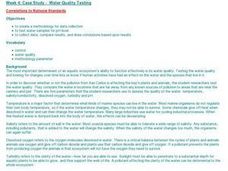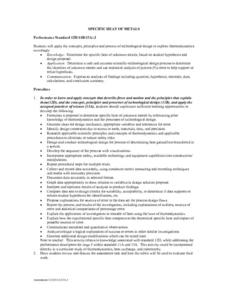Curated OER
Balloon Rockets
Students, after reviewing and analyzing Newton's third law of motion, make balloon rockets and experiment with a variety of models. After the experiment, they chart the results and form conclusions. In addition, they compare/contrast...
Curated OER
Food Myths Critical Thinking and Reading
Students read a series of statements made by students about the hazards and benefits of various foods. They distinguish the "facts: from "opinions" in the dialogue, summarize the facts in a short paragraph, and write an essay...
Curated OER
Ethical and Critical Thinking: Genetically Modified Food
Young scholars read statements representing different points of view on Genetically Modified Food. They identify the "facts" and "opinions" in each statement, and then briefly summarize the issue of Genetically Modified Food in a short...
Curated OER
Water Quality Testing
Student explore factors affecting ecosystems. They test local water samples for pH level. After creating a methodology for data collection, they collect data, compare results, and draw conclusions based upon results.
Curated OER
If I Could Have Lived in Another Time or Culture
Third graders develop multi-paragraph compositions. They include an introduction, first and second level support, and a conclusion. They use a variety of sentence structures (e.g., simple, compound/complex) and sentence types (i.e.,...
Curated OER
SAFETY KNOWLEDGE BASE CHANGES
Middle schoolers research and formulate a hypothesis for research to correlate changing safety regulations in regards to personal and environmental safety polices for storage, handling and disposal of chemicals, risk involved in...
Curated OER
Specific Heat of Metals
Students determine the specific heat of unknown metals. based on their hypothesis and design proposal. They analyze the findings of the specific heat of the unknown metals. Students complete this by questions, hypothesis, rationale,...
Curated OER
GLOBALIZATION
Students define the concept of the global community. They analyze characteristics of global communities using Stark's three categories: communication, economy, and culture/community. They write a five-paragraph essay which includes an...
Curated OER
Held Accountable
Learners examine and draw conclusions from an excerpt from a slave narrative. They analyze excerpts from two recently discovered slave narratives.
They draw connections among the narrative excerpts and historical texts by investigating...
Curated OER
Mission Makeover
Students examine their prior knowledge of the space program. After reading an article, they explore the conclusions of the Columbia accident. In groups, they research various space programs and discover the scope of NASA. They write...
Curated OER
A History of Conflict
Students explore issues contributing to current tensions between Pakistan and India, drawing conclusions about how the conflict came about and where it may be heading. They Participate in an in-class "diplomacy summit"; create a...
Curated OER
Deducing Induction
Students examine how changing magnetic fields induce currents in
loops and coils, determine orientation and magnitude of magnetic field,
describe Michael Faraday's experiments that led to conclusion that changing
magnetic force induces...
Curated OER
Effects of Water Pollution on Aquatic Organisms
Students investigate water pollution. They develop an understanding of the behavior of organisms, of the structure and properties of matter, and of natural and human induced hazards by conducting lab tests. They present their data...
Curated OER
THE GREAT DEPRESSION THROUGH PHOTOGRAPHS
Learners, investigating and analyzing the period known as the Great Depression, view and critique photographs of the agricultural Acadian community in the St. John Valley. They assess the photographs to make conclusions about the...
Curated OER
How Much Salt is in the Gsl Water?
Fourth graders study the water cycle and the different processes that are involved, like precipitation, evaporation, etc. They conduct an experiment observing the water cycle in action and write a hypothesis, observations and...
Curated OER
Will the Lights Go Out?
Students diagram nuclear power plant, describe process for generating electrical power, discuss nuclear disasters in the 20th century, and draw conclusion about value of nuclear power for the future.
Curated OER
Composting
Students survey what composting is. They observe the benefits of composting over the course of the school year by making your own composters and gardens. Group members compare two different compost piles, make conclusions about...
Curated OER
Rivers Through Time
Students read or have the book A River Ran Wild read to them. They discuss and reflect on the messages presented in the book. Students use their listening comprehension skills to draw conclusions. Students articulate several examples of...
Curated OER
High Mountain Retreat
Learners explore and analyze atmospheric conditions for a high mountain retreat. They examine the relationship between altitude, atmospheric pressure, temperature and humidity at a particular location. In addition, they write reports...
Curated OER
Forces in the Sport of Luging
Students discuss force, gravity, and friction as well as examples of each based on what they viewed during a Discovery video. They examine first hand the effect of forces by building their own luge track, making predictions, and testing...
Curated OER
Analysis of Data
Learners analyze DNA banding patterns for similarities and differences among individuals and between populations. They examine individual prepared gels then pool the class data to come to an overall conclusion.
Curated OER
How Does the Sun Seem To Move?
In this sun worksheet, learners will fill in the blank of 3 statements about observing the movement of the sun. Then students will fill in the blank of a conclusion they develop from the facts. This worksheet is a graphic organizer.
Curated OER
How Do Single-Celled Organisms Live?
For this single-celled organisms worksheet, students write in how an amoeba, paramecium, and euglena move. Based on these facts, students come to a conclusion about how these organisms live. This worksheet has 4 short answer questions.
Curated OER
The Effects of Light Intensity and Wavelength on the Rate of Photosynthesis
Students use an on line website to simulate the effects of light intensity and wavelength on photosynthesis. In this photosynthesis lesson plan, students determine how wavelength of light and intensity of light affect the rate at which...
Other popular searches
- Drawing Conclusions
- Drawing Conclusions Reading
- Draw Conclusions
- Writing Conclusions
- Conclusion Sentences
- "Drawing Conclusions
- Inference and Conclusions
- Drawing Conclusion Stories
- And Conclusions
- Writing a Conclusion
- Nonfiction Draw Conclusions
- Conclusion Paragraph

























